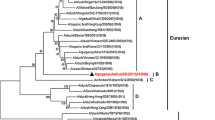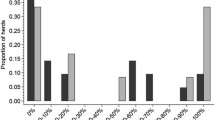Abstract
Currently, three predominant subtypes of influenza virus are prevalent in pig populations worldwide: H1N1, H3N2, and H1N2. European avian-like H1N1 viruses, which were initially detected in European pig populations in 1979, have been circulating in pigs in eastern China since 2007. In this study, six influenza A viruses were isolated from 60 swine lung samples collected from January to April 2011 in eastern China. Based on whole genome sequencing, molecular characteristics of two isolates were determined. Phylogenetic analysis showed the eight genes of the two isolates were closely related to those of the avian-like H1N1 viruses circulating in pig populations, especially similar to those found in China. Four potential glycosylation sites were observed at positions 13, 26, 198, 277 in the HA1 proteins of the two isolates. Due to the presence of a stop codon at codon 12, the isolates contained truncated PB1-F2 proteins. In this study, the isolates contained 591Q, 627E and 701N in the polymerase subunit PB2, which had been shown to be determinants of virulence and host adaptation. The isolates also had a D rather than E at position 92 of the NS1, a marker of mammalian adaptation. Both isolates contained the GPKV motif at the PDZ ligand domain of the 3′ end of the NS1, a characteristic marker of the European avian-like swine viruses since about 1999, which is distinct from those of avian, human and classical swine viruses. The M2 proteins of the isolates have the mutation (S31N), a characteristic marker of the European avian-like swine viruses since about 1987, which may confer resistance to amantadine and rimantadine antivirals. Our findings further emphasize the importance of surveillance on the genetic diversity of influenza A viruses in pigs, and raise more concerns about the occurrence of cross-species transmission events.
Similar content being viewed by others
References
Basler C F, Aguilar P V. 2008. Progress in identifying virulence determinants of the 1918 H1N1 and the Southeast Asian H5N1 influenza A viruses. Antiviral Res. 79:166–178.
Bi Y, Fu G, Chen J, et al. 2010. Novel swine influenza virus reassortants in pigs, China. Emerg Infect Dis, 16:1162–1164.
Brown I H. 2000. The epidemiology and evolution of influenza viruses in pigs. Vet Microbiol, 74:29–46.
Dunham E J, Dugan V G, Kaser E K, et al. 2009. Different evolutionary trajectories of European avian-like and classical swine H1N1 influenza A viruses. J Virol, 83:5485–5494.
Fan X, Zhu H, Zhou B, et al. 2012. Emergence and dissemination of a swine H3N2 reassortant with 2009 pandemic H1N1 genes in pigs in China. J Virol, 88:2375–2378.
Fouchier R A, Munster V, Wallensten A, et al. 2005. Characterization of a novel influenza A virus hemagglutinin subtype (H16) obtained from black-headed gulls. J Virol, 79:2814–2822.
Glaser L, Stevens J, Zamarin D, et al. 2005. A single amino acid substitution in 1918 influenza virus hemagglutinin changes receptor binding specificity. J Virol, 79:11533–11536.
Gregory V, Lim W, Cameron K, et al. 2001. Infection of a child in Hong Kong by an influenza A H3N2 virus closely related to viruses circulating in European pigs. J Gen Virol, 82:1397–1406.
Hatta M, Gao P, Halfmann P. 2001. Molecular basis for high virulence of Hong Kong H5N1 influenza A viruses. Science, 293:1840–1842.
Hoffmann E, Stech J, Guan Y, et al. 2001. Universal primer set for the full-length amplification of all influenza A viruses. Arch Virol, 146:2275–2289.
Ito T, Couceiro J N, Kelm S, et al. 1998. Molecular basis for the generation in pigs of influenza A viruses with pandemic potential. J Virol, 72:7367–7373.
Karasin A I, Landgraf J, Swenson S, et al. 2002. Genetic characterization of H1N2 influenza A viruses isolated from pigs throughout the United States. J Clin Microbiol, 40:1073–1079.
Korteweg C, Gu J. 2008. Pathology, molecular biology, and pathogenesis of avian influenza A (H5N1) infection in humans. Am J Pathol, 172:1155–1170.
Krumbholz A, Schmidtke M, Bergmann S, et al. 2009. High prevalence of amantadine resistance among circulating European porcine influenza A viruses J Gen Virol, 90:900–908.
Liu J, Bi Y, Qin K, et al. 2009. Emergence of European avian influenza virus-like H1N1 swine influenza A viruses in China. J Clin Microbiol, 47:2643–2646.
Matrosovich M, Tuzikov A, Bovin N, et al. 2000. Early alterations of the receptor-binding properties of H1, H2, and H3 avian influenza virus hemagglutinins after their introduction into mammals. J Virol, 74:8502–8512.
Olsen C W, Karasin A I, Carman S, et al. 2006. Triple reassortant H3N2 influenza A viruses, Canada, 2005. Emerg Infect Dis, 12:1132–1135.
Peiris J S, de J, Guan Y. 2007. Avian influenza virus (H5N1): a threat to human health. Clin Microbiol Rev, 20:243–267.
Pensaert M, Ottis K, Vandeputte J, et al. 1981. Evidence for the natural transmission of influenza A virus from wild ducts to swine and its potential importance for man. Bull World Health Organ, 59:75–78.
Qi X, Lu C P. 2006. Genetic characterization of novel reassortant H1N2 influenza A viruses isolated from pigs in southeastern China. Arch Virol, 151:2289–2299.
Qi X, Pang B, Lu C P. 2009. Genetic characterization of H1N1 swine influenza A viruses isolated in eastern China. Virus Genes, 39:193–199.
Rambaut A, Pybus O G, Nelson M I, et al. 2008. The genomic and epidemiological dynamics of human influenza A virus. Nature, 453:615–619.
Shinde V, Bridges C B, Uyeki T M, et al. 2009. Triple-reassortant swine influenza A (H1) in humans in the United States, 2005–2009. N Engl J Med, 360:2616–2625.
Smith G J, Vijaykrishna D, Bahl J, et al. 2009. Origins and evolutionary genomics of the 2009 swine-origin H1N1 influenza A epidemic. Nature, 459:1122–1125.
Starick E, Lange E, Fereidouni S, et al. 2011. Reassorted pandemic (H1N1) 2009 influenza A virus discovered from pigs in Germany. J Gen Virol, 92:1184–1188.
Steel J, Lowen AC, Mubareka S, et al. 2009. Transmission of influenza virus in a mammalian host is increased by PB2 amino acids 627K or 627E/701N. PLoS Pathog, 5:e1000252.
Subbarao E K, London W, Murphy B R. 1993. A single amino acid in the PB2 gene of influenza A virus is a determinant of host range. J Virol, 67:1761–1764.
Tamura K, Dudley J, Nei M, et al. 2007. MEGA4: Molecular Evolutionary Genetics Analysis (MEGA) software version 4.0. Mol Biol Evol, 24:1596–1599.
Tumpey T M, Maines T R, Van H N, et al. 2007. A two-amino acid change in the hemagglutinin of the 1918 influenza virus abolishes transmission. Science, 315:655–659.
Vijaykrishna D, Poon L L, Zhu H C, et al. 2010. Reassortment of pandemic H1N1/2009 influenza A virus in swine. Science, 328:1529.
Vijaykrishna D, Smith G J, Pybus O G, et al. 2011. Long-term evolution and transmission dynamics of swine influenza A virus. Nature, 473:519–522.
Webby R J, Swenson S L, Krauss S L, et al. 2000. Evolution of swine H3N2 influenza viruses in the United States. J Virol, 74:8243–8251.
Webster R G, Bean W J, Gorman O T, et al. 1992. Evolution and ecology of influenza A viruses. Microbiol Rev, 56:152–179.
Weis W, Brown J H, Cusack S, et al. 1988. Structure of the influenza virus haemagglutinin complexed with its receptor, sialic acid. Nature, 333:426–431.
Xu C, Zhu Q, Yang H, et al. 2009. Two genotypes of H1N2 swine influenza viruses appeared among pigs in China. J Clin Virol, 46:192–195.
Yamada S, Hatta M, Staker B L, et al. 2010. Biological and structural characterization of a host-adapting amino acid in influenza virus. PLoS Pathog, 6:e1001034.
Yu H, Hua R H, Zhang Q, et al. 2008. Genetic evolution of swine influenza A (H3N2) viruses in China from 1970 to 2006. J Clin Microbiol, 46:1067–1075.
Zhou N N, Senne D A, Landgraf J S, et al. 1999. Genetic reassortment of avian, swine, and human influenza A viruses in American pigs. J Virol, 73:8851–8856.
Zhu H, Webby R, Lam T T, et al. 2011. History of Swine Influenza Viruses in Asia. Curr Top Microbiol Immunol, DOI:10.1007/82_2011_179.
Author information
Authors and Affiliations
Corresponding author
Additional information
Foundation items: Supported by the Natural Science Foundation of Jiangsu Province (BK2009434); the Innovation Platform for Public Health Emergency Preparedness and Response (NO.ZX201109) and the Key Medical Talent Foundation of Jiangsu Province (RC2011084).
Rights and permissions
About this article
Cite this article
Qi, X., Pan, Y., Qin, Y. et al. Molecular characterization of avian-like H1N1 swine influenza a viruses isolated in Eastern China, 2011. Virol. Sin. 27, 292–298 (2012). https://doi.org/10.1007/s12250-012-3262-9
Received:
Accepted:
Published:
Issue Date:
DOI: https://doi.org/10.1007/s12250-012-3262-9




